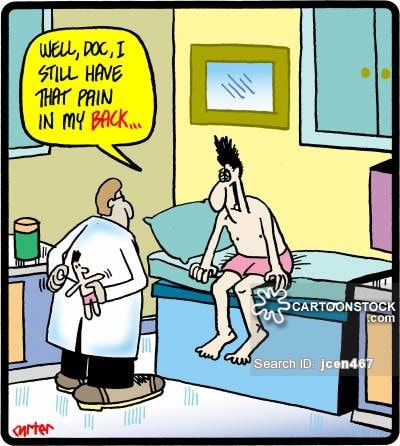Why Does My Back Still Hurt... 5 Years Later?
Aug 14, 2017
That’s a funny cartoon, but back pain is no joke. Chronic low back pain is the leading cause of disability in the world. Throughout our lives, 80% of us will experience low back pain. So why do some recover completely while others have chronic, sometimes debilitating, back pain?
As movement specialists, we (physical therapists) often want to explain the why of pain with muscles, joints, and movement patterns. Sure, we can work on asymmetries in movement and perceived muscle weakness but for chronic pain this is only a small piece of the puzzle.
Back pain can be particularly frustrating for a few reasons. For one, imaging does not directly correlate to pain nor does it change conservative treatment strategies. Also, improvement from back pain often has ups and downs, sometimes with no indication of what causes it.
What NOT to do if you have back pain:
Going straight to the orthopedic for back pain can start a cascade of chronic back pain. Lumbar spine imaging should not be the first line of care for back pain. I see it too often - either the imaging shows something that seems “scarier” than the pain the patient feels OR the pain is quite intense but the image shows nothing out of the ordinary. The latter tends to be the most frustrating. If there is nothing torn, bulging, ripped, degenerating (insert any other terrible descriptor here), then why the heck does my back hurt SO BADLY?
Our nervous system is extraordinary because it has the ability to adapt and change with our stimuli- inside and out. This becomes a problem when it adapts in a way that we call “central sensitization.” Essentially, the central nervous system (brain and spinal cord) becomes extra sensitive to stimuli. So something that should cause little pain, or none at all, sends serious threat signals to the brain which leads to pain.
The best analogy commonly used is the house alarm. If a burglar breaks the window in my house, I expect the alarm to sound. However, if a tree branch scrapes the window, I do not expect the alarm to sound. But with central sensitization, the alarm does go off. And this alarm is PAIN.
Check out this cool video about chronic pain. It only takes a few minutes: Explain Pain
Is it a false alarm?
Based on the healing rates for tissues in the body, we know that after a few years into back pain, the pain is not stemming from actual tissue damage. If there continues to be pain similar to the original onset, it is likely that there are some central nervous system changes.
When working through this with patients, it always starts with education so that they understand I am acknowledging that they feel the pain but also that they understand pain DOES NOT equal damage. To progress towards improved function and a pain-free active lifestyle, we focus on repetition of basic movements that may or may not be painful. The idea is to train the neurological system that simple bending over should not be threatening or painful. That being said, sometimes it is painful! In that case, I set the following rules: if the pain is low level and constant we are ok to work in that range, and if pain begins to escalate throughout the movement we will take a break. But as you build resilience and confidence through the movement range, you will experience less pain and the central nervous system will lessen the threat associated with that movement.
TAKE AWAYS:
- The pain that you are feeling is real. It’s not in your head or made up, rather your central nervous system is telling you to feel pain.
- Pain does NOT equal damage. Our nervous system misinterprets signals as pain, so if the CNS is sensitized, pain will occur without tissue disruption.
- Start with movements that are fundamental. Sitting and standing from a chair, bending to pick up a light object, rolling over in bed—each of these are common pain producers but should not be threatening to the body. If there is low level discomfort through the movement, that is ok.
- Seek help from a physical therapist. MRI and X-ray is obsolete with chronic pain. Most times, the findings are not helpful. They can be frustrating and will likely not change the course of conservative management (physical therapy)! Check out Dr. Jake's blog for more on this subject.
At Athletes’ Potential, we treat a lot of back pain. A story that we hear often is that people have bounced between providers, tried more severe/invasive treatments, long term use of pain meds or anti-inflammatory drugs, etc., but still have pain! We specialize in helping people maintain a pain-free, high-level, and active lifestyle. Whether this looks like running marathons, lifting heavy weights, or playing with your kids, we can help you get there. If this sounds like your past and the future you want, give us a call. We would love to help!
Thanks for reading,
Athletes' Potential
Let us help you figure out to live your best active life today!
Remember, Movement is Medicine!

